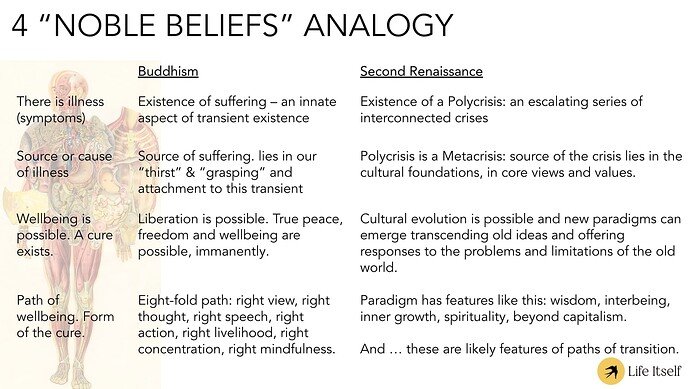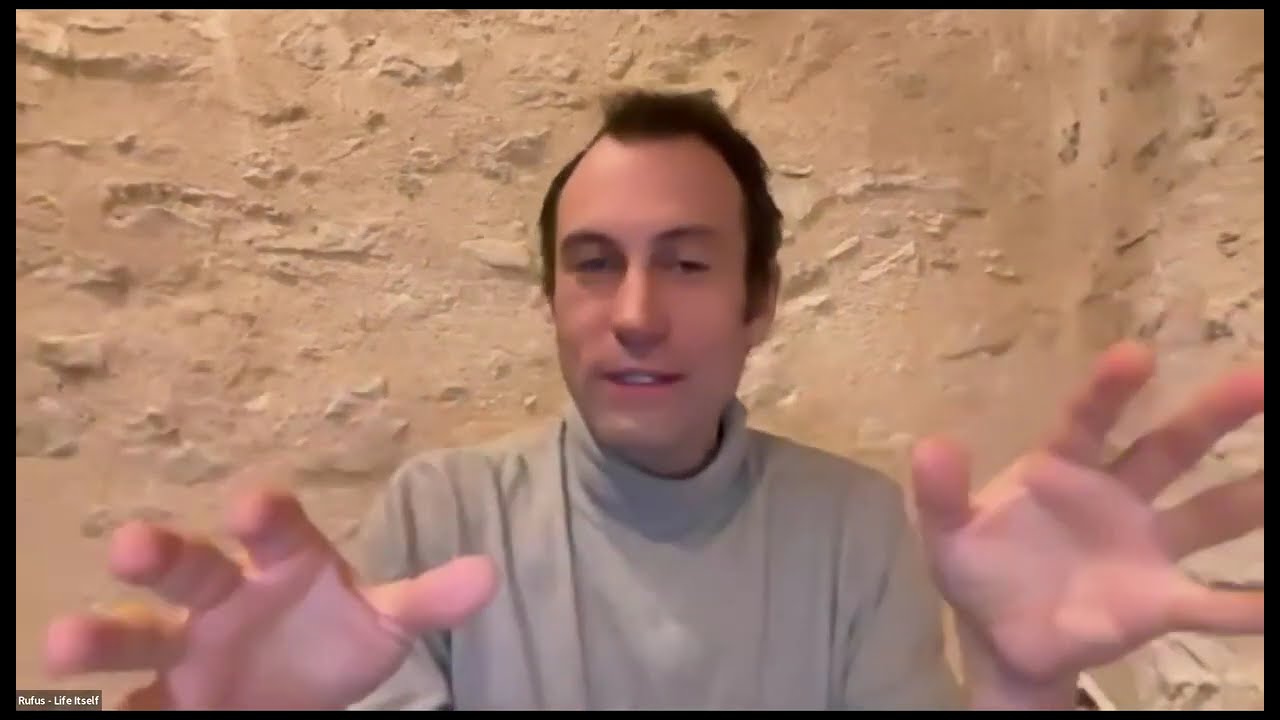A distillation of the core thesis / credo of the second renaissance into four key theses. The four noble beliefs were present but not labelled explicitly as such from the very first version of the narrative published on the second renaissance website in May 2024.
Being somewhat familiar with Thich Nhat Hahn’s wider of body of work, I’m wondering if the proposed update to the Four Noble Truths improves on the previous version. If so, how? If the paradigm of Modernity is the root cause of current suffering, then what was the root cause of the paradigm of Modernity? Did the Axial traditions fail us? If so, why?
Funny you post now ; I was just myself these last few hours working on a similar formalization of necessary & sufficient conditions for inclusion under the 2R banner.
I’d so-far arrived at :
A movement is part of the Second Renaissance IFF it is (1) responsive to emergent crises of coordination (2) through an integrative epistemic pluralism which (3) marries inner transformation & systemic change (4) by leveraging intra-/inter-personal technologies (5) reified in communities of practice.
…when I decided what I’d produced was something of a dumb idea overall and had given up in my intention to publish it… but since you’ve brought it up ~
A post was split to a new topic: What do we mean by Axial traditions?
A post was merged into an existing topic: What do we mean by Axial traditions?
Re: “The root cause of these crisis lies in the cultural paradigm of Modernity”.
This makes it sound like postmodernism is the solution. It doesn’t acknowledge even the possibility that postmodernism is also a central part of the problem. Modernism is indeed the root cause of most of the problems. (EDIT: Actually this answer is wrong. I don’t believe modernism is the root cause of even most of the problems. I think that is far too simplistic. The problems are more fundamental than that.) Postmodernism is an attempted cure, and I think it is essential to recognise that the cure turned out to be at least as bad as the illness. It made our overall situation worse. Postmodernism is preventing any possibility of a Second Renaissance.
My biggest problem with the concept of 2R is the inconsistency in this respect. It is why I can’t accept the concept of metamodernism and I was hoping the problem could be avoided at this broader level – at this “metamovement” level. Some of the time I am being assured that people understand this – that it is fully acknowledged that postmodernism is part of the problem. And then I read something like this, and it seems like postmodernism hasn’t gone away.
Can you clear this up for me? What is the relationship between postmodernism and 2R? Or am I correct in thinking this is an unresolved issue?
I believe this must be resolved. There cannot be a “fuzzy” answer.
Good point to flag, and it is a bit more nuanced than that. I think we got this (most) correct so far in the intro to the second whitepaper (We spent quite a bit of time word-smithing this):
These interconnected crises have common roots in innate human tendencies combined and exaggerated by the decaying cultural paradigm of modernity in which most of humanity now lives
The key point is that it is not like it is “all modernity’s fault”. Rather there are innate/deep human tendencies (think grasping in Buddhist teaching) which modernity (in its decay phase) exacerbates / exaggerates etc.
Concrete example: consumerism or junk food or netflix or even social media algorithms.
It’s not like late-stage modernity capitalism is the sole cause of junk food and obesity – there are deep things in human biology and psychology that cause us to like the sugar rush. And modern capitalism optimizes to “exploit” that tendency in a supercharged way.
Same with ecological crisis: humanity has had collective action problems managing common resources for millenia (if not even further back). But globalized capitalism (or communism) takes to a whole new level – this is the wisdom gap issue.
Same with social media: they are after all (to a great extent) just giving people what they want (i.e. more of what they clicked on). And novel info seeking (leading to info-obesity) is coming from a deep tendency … but profit-driven social media giants have these massive incentives to exploit this.
etc
To check are you meaning the “buddhist” column in that table? If so, no i’m not proposing that an update or improvement – I just put together a succinct summary.
BTW: I personally prefer TNH’s overall framing in the Heart of the Buddha’s teaching as a very most positive, accessible version (as well as his extended beef with overdoing of “suffering” in the Theravadan tradition).
Overall i should emphasize that the analogy more rests on the underlying shared metaphor or illness. My guess is that the Buddha created the 4NT structure precisely based on the medical metaphor/analogy b/c it was easy to grasp.
I wouldn’t say they failed - rather that in terms of worldviews it is time to transcend and include.
I emphasize worldviews as the Axial age also brought new found insight/perspectives into “waking up” as well as “growing up” and those insights are more into “eternal truth” e.g. Buddha’s teaching on liberation.
I think this is brilliant distillation. The analogy with Buddhist tradition is a great way of opening up a richness of meaning in what would otherwise seem like four abstract principles. Yet at the same time it clearly goes way beyond traditional buddhism - which has tended towards political quietism - in translating from individual psychology to society as a whole in a metacrisis context.
I also love the fact that buddhist practice services a kind of existence proof here: if radical experiential change is possible for an individual, it seems in principle possible for a whole culture.
My point of entry for the “Axial” theme is every single Axial tradition (Chinese, Indic, Abrahamic, Hellenic) is perfectly serviceable. But they all share one critical flaw in our current situation. They were not formed in awareness of one another. They all arose as ways to transcend prior mythic traditions in their particular geographic arenas. (And they accomplished that differently, so let’s not derail into reductionist false equivalencies - more like structural similarities). Which I take to mean 1) they all offer potential wisdom to our current situation but 2) we need something new to frame them all, to bring them into proper relations with one another, and with the scientific method that post-dated all of them.
So on the 4NT question, I believe the original Buddhist 4NT are fine as far as they go. Where they don’t go is in addressing Jesus, Muhammad, Confucius, Plato, Newton, or Einstein. So I sympathize with your desire to update. But some haggling on details may be required …
Why was my question removed…?
An admin split it to its own topic because it was a great standalone question - no intention to cause upset (if a problem it can be moved back).
Not that important to me where the definition of “Axial” lives as long as everyone understands the reference. Why? Because it’s fairly critical to how I believe we should understand “second” renaissance.
First (European) Renaissance recovered: Greco-Roman classicism + biblical philology
Second Renaissance must recover not just those, but also Axial traditions of Chinese and Indian origin, proto-Islam, and numerous spiritual traditions from Africa, the Americans, Oceania, and elsewhere in the world. (Also note - other places - China for example - had their own prior returns to their own classic sources from time to time).
Have you heard of this book?
If any of this is close to accurate, not interested.
I wasn’t recommending it. I was just interested to see if you were aware of it.
I think there is some truth in it – and relevant to the things you are talking about – but there’s also a lot of murky bathwater.


